Honda V5
#1

Posted 04 April 2001 - 19:33
Advertisement
#2

Posted 04 April 2001 - 19:36
Niall
#3

Posted 04 April 2001 - 20:16
#4

Posted 04 April 2001 - 21:52
#5

Posted 05 April 2001 - 04:45
Originally posted by Nathan
Honda was "suppose" to have a 2.5-Liter V-5 made for the S2000 back when the concept was first released to the public. So Im going to go out on a limb and say I wouldnt doubt this, since they have previous (granted limite) experiance with it.
There has been a trend to put balance pretty far down on the list of priorities for pure racing engines. As bore:stroke ratios have climbed to well above 2:1, and titanium rods and ever decreasing crankpin diameters have become the norm, the imbalance forces have become managable, so packaging, friction reduction, and power potential come first... i.e. build whatever configuration suits your needs and live with the (micro) shakes.
The S2000 2.5L V5, with an emissions-driven bore/stroke of 87mm/84mm is an entirely different world from the F1 bike engine, and probably requires a balance shaft due to the long stroke. The 990cc V5, with only a 38mm stroke, was probably configured only for compact packaging and nearly evenly spaced power pulses.
#6

Posted 05 April 2001 - 06:26
#7

Posted 05 April 2001 - 07:20
I wonder why the FIM allows more technical innovation than F1, the supposed pinnacle of motorsport? Sad really.
#8

Posted 05 April 2001 - 21:03
The reasons are supposedly increased weight and that too much power would simply chew that rear tyre.
#9

Posted 05 April 2001 - 21:39
Originally posted by Alex
I've heard that they will not go with full 990cc displacement, but rather keep it somewhere around 800cc.
The reasons are supposedly increased weight and that too much power would simply chew that rear tyre.
All kinds of rumors, but that would only decrease engine width 18 mm, decrease weight very little, and lose you 20% of your top end power. There are better ways to handle tire wear without getting smoked at any track with a long straight.
#10

Posted 06 April 2001 - 08:55
For anyone interested in motor cycles especially or most people in this forum I'm sure, I can recommend The Britten Story video about the New Zealand built Britten V Twin bike. Absolutely staggering that they built a bike in a back shed that could blow away factory Ducati Superbikes at Daytona!
#11

Posted 06 April 2001 - 16:16
#12

Posted 06 April 2001 - 17:57
Originally posted by wheel
why not just build a v8 like drysdale engineering from australia. more cyls. more speed more power.
More cylinders does not always mean more power. At some point, friction increases overcome the valve area increase. Note that F1 3.0L engine designers settled on V10s over V12s when they had a choice... it was a borderline decision, and when it looked like new developments tilted it toward V12s, an economic decision was made to mandate V10s. If the choice between 300cc per cyl and 250cc per cyl was borderline for them, it looks like 4 cylinders would be ideal (for the 990) if pneumatic valve closure were legal. Perhaps metal valve springs are required(?), pushing Honda to 5 cylinders to boost the valvetrain RPM limit. More cylinders always equates to more weight and usually less efficient packaging also. Some are choosing inline 4s and some are choosing a V3 for these new regs. Note also that the 5 cyl gets a 22 pound weight break over a 6 or more cyl. And the V3 gets an additional 22 pound weight break! Pretty significant.
Four-stroke GP's: The Basic Regulations
Engine Displacement
Four-strokes maximum 990cc, two-strokes maximum 500cc
Minimum weights
Four-strokes, two/three cylinders 135kg
Four-strokes, two/three cylinders (oval pistons) 145kg
Four-strokes, four/five cylinders 145kg
Four-strokes, four or more cylinders (oval pistons) 155kg
Four-strokes, six or more cylinders 155kg
Two-strokes, four cylinders 130kg
Fuel tank capacity
Four-strokes, maximum 24 liters (22 liters from 2004)
Two-stroke, maximum 32 liters
Noise limits
Pre-race limit: 115 db(A)
Post-race limit: 120 db(A)
All other technical regulations according to current terms. Detail regulations still under discussion. Final regulations will be ratified "some time before the end of 2000."
#13

Posted 06 April 2001 - 18:38
overcome the valve area increase."
Actually counter to intuitive reasoning, an increase in cylinder multiplicity does not mean necessarily higher frictional losses. From SAE Paper 983035 "Comparison of V10 and V12 F1 Engines" by Boretti and Cantore:
"The V12 engine has a mep(f) always smaller than the mep(f) of the V10 running at the same speed. Opposite to series engines running low Rpms, where increasing the number of cylinders means increased friction, in racing engines running high Rpms, friction reduces by increasing the number of cylinders."
#14

Posted 06 April 2001 - 21:22
Originally posted by desmo
"The V12 engine has a mep(f) always smaller than the mep(f) of the V10 running at the same speed. Opposite to series engines running low Rpms, where increasing the number of cylinders means increased friction, in racing engines running high Rpms, friction reduces by increasing the number of cylinders."
Are they comparing existing or hypothetical engines? You should compare engines of identical bore/stroke ratio and indentical rod_length/stroke ratio to keep rod angularity differences from skewing the results. Also note it says "running at the same speed" which ignores the principal reason for running more cylinders; to overcome RPM limitations and run more RPMs.
I'll have to download the paper and see what their reasoning and proof is. Those names sound Italian... maybe they're partial to V12s.
#15

Posted 09 April 2001 - 07:11
Originally posted by Engineguy
I'll have to download the paper and see what their reasoning and proof is. Those names sound Italian... maybe they're partial to V12s.I'm anxious to see at what RPM the laws of physics reverse themselves!

I've seen the paper. These chaps are obviously big V12 fans. As I remember it, they seem to be quite biased toward the V12 from the outset. I'm with you on this one Engineguy, running at optimal conditions, a V12 might have more power, but also with increased friction. Years ago people tried building 10 cylinder 500cc two-stroke GP bikes (1970's: 10 x ITOM 50cc cylinder on a common crankcase). It failed dismally, as frictional losses were so high
#16

Posted 09 April 2001 - 08:52
Are they comparing existing or hypothetical engines?
"Computations are performed here by using the WAVE code that is developed by Ricardo North America...Friction values are obtained by using a certainly less reliable empirical method. Such technique represents typical rapid methods that are often used to obtain a feel for a complex subject based on a limited amount of experimental data. Consequently, results in term of friction and brake values have to be considered very carefully."
This paper was written by engineers working on Ferrari's F1 engine development program. The caveats about the results give pause, but I wouldn't discount their observations simply because they do not meet fully scientific standards of repeatability, transparancy and peer review. The logistics of developing racing engines necessarily doesn't allow for the time or money to work to scientific standards.
You should compare engines of identical bore/stroke ratio and indentical rod_length/stroke ratio to keep rod angularity differences from skewing the results.
"We consider engines of similar design, having the same displacement, but a different number of cylinders. Engines have equal bore/stroke, connecting rod length/stroke, intake and exhaust valve diameter/bore ratios, and equal maximum power mean piston speed."
The authors acknowledge the effect of rpm on friction correctly noting that many of the friction pressures are a function of rpm squared.
My gut says that the increase in the area of the cylinder swept area, port area, bearing area etc. would likely result in a higher friction pressure for more cylinders all else being equal or as equal as is practical, but I am by no means confident enough in my intuition to challenge the findings of this paper.
Halfwitt- unless I am way off base there were no 10 cylinder GP bikes 2 or 4 stroke. Guzzi's V-8 and Honda's pseudo V-8 NR- both 4 strokes- were as close as anyone ever got. In fact I cannot recall a 2 stroke GP bike with more than 4 cylinders although perhaps they have been tried.
#17

Posted 09 April 2001 - 15:50
I can't recall any other two-strokes with more than 4 cylinders, but I am sure someone must have tried it.
#18

Posted 10 April 2001 - 16:45
here's a snippet from a trackside observer about the V5 after it's first run (from MCN)
"We know the engine is a water-cooled V5, with cylinders in three-forward/two-backward formation, but that's about it.
The exact capacity is still secret, as is the firing order of the engine or how Honda have balanced it, but a clue to both of those questions comes in the reported sound of the engine: despite having more than twice as many cylinders as something like a VTR1000 SP-1, observers said it sounded just like a massive V-twin.
This could mean that Honda are firing each bank of cylinders separately, with the front three in one big bang and the rear two in a smaller bang, and adding a balance shaft to the rear two-cylinder bank to balance it against the front trio."
#19

Posted 12 April 2001 - 00:20
Advertisement
#20

Posted 17 June 2001 - 18:39
Honda RC211V
4-stroke V5, 20 valves, 990cc, V-angle=75.5, No balancer, Engine weight=NSR500 x 110%
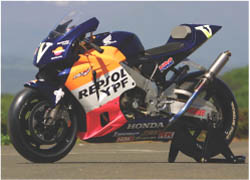
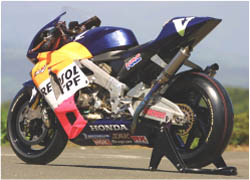
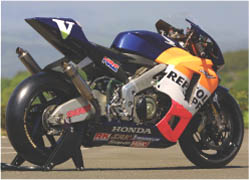
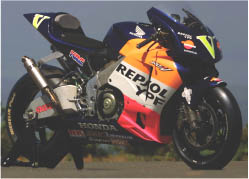
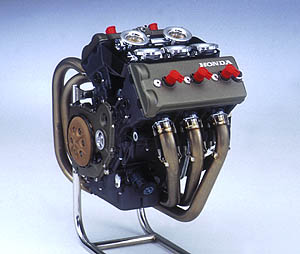
#21

Posted 18 June 2001 - 00:40
thanx for the pics MN:up:
#22

Posted 18 June 2001 - 01:03
#23

Posted 18 June 2001 - 02:31
#24

Posted 18 June 2001 - 03:30
Originally posted by Wolf
Is it just me, or are those 10% for almost twice as much displacement AND strokes, a bit too small a weight increase? I mean, for entire bike it would be OK, I guess- but for just an engine....
Well, I'm pretty sure that they can make it even lighter if they
wish to but the minimum weight required by FIM regurations is rather heavy.
135Kg: 3 cyl or less
145Kg: 4 or 5 cyl
155Kg: 6 cyl
#25

Posted 20 June 2001 - 09:16
Originally posted by desmo
I agree Wolf. If that figure is correct, that can only mean the NSR500 engine was massively overweight. I actually read it at first as NR500, so it seemed semi-plausible.
Might it be that the engine was made deliberately overweight to get the C of G right? When they increased bike weight from 115 to 135 kg the scope was there to do this.
#26

Posted 20 June 2001 - 17:59
#27

Posted 20 June 2001 - 22:25
Originally posted by Fudman
For anyone interested in motor cycles especially or most people in this forum I'm sure, I can recommend The Britten Story video about the New Zealand built Britten V Twin bike. Absolutely staggering that they built a bike in a back shed that could blow away factory Ducati Superbikes at Daytona!
There wind tunnel was one guy sitting on the bike and another guy looking to see if it looked good.
If you want to know more about eh Brittens have a look at http://www.britten.co.nz/
#28

Posted 12 August 2001 - 18:18
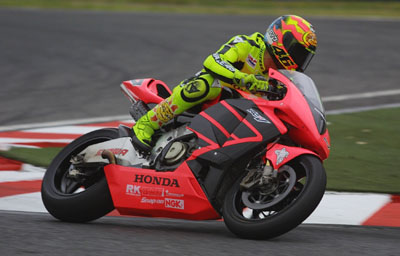
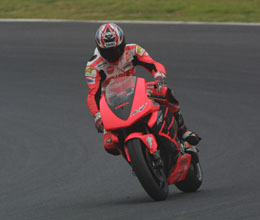
#29

Posted 13 August 2001 - 09:10
http://www.tochigine...A/wgp/rc211v.rm


















